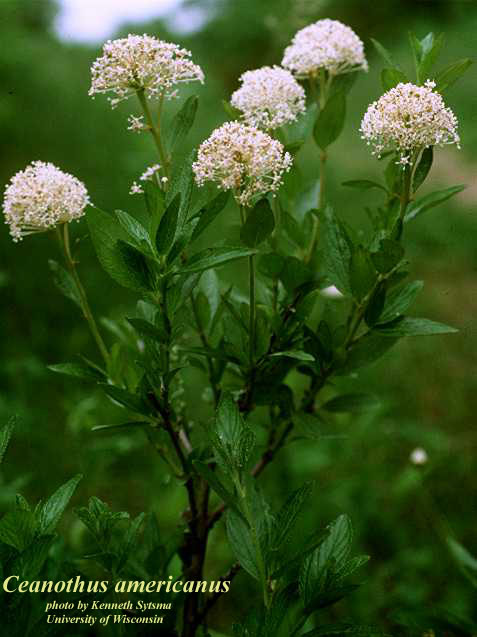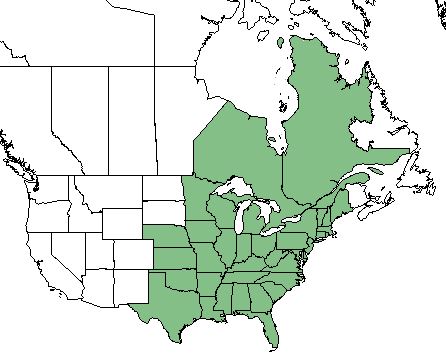Difference between revisions of "Ceanothus americanus"
(→Use by animals) |
(→Use by animals) |
||
| Line 49: | Line 49: | ||
===Pollination=== | ===Pollination=== | ||
Bees may collect pollen from the plant and other insects such as butterflies and moths may just collect nectar. <ref name= "USDA"/> | Bees may collect pollen from the plant and other insects such as butterflies and moths may just collect nectar. <ref name= "USDA"/> | ||
| − | ===Use by animals=== | + | ===Use by animals=== <!--Herbivory, granivory, insect hosting, etc.--> |
| − | It averages to 10-25% of the diet for large mammals, and 2-5% of the diet for terrestrial birds.<ref name= "Miller">Miller, J.H., and K.V. Miller. 1999. Forest plants of the southeast and their wildlife uses. Southern Weed Science Society.</ref> | + | It averages to 10-25% of the diet for large mammals, and 2-5% of the diet for terrestrial birds.<ref name= "Miller">Miller, J.H., and K.V. Miller. 1999. Forest plants of the southeast and their wildlife uses. Southern Weed Science Society.</ref> The leaves are browsed on by rabbit, deer, and elk, and the fruit is eaten by quail and turkey. Caterpillars of the summer azure (''Celestina neglecta'') and the Mottled Duskywing (''Erynnis martialis'') feed upon the flower buds, flowers, and fruit of this species and many others. Historically, Native American tribes in the Missouri River region utilized the leaves to make tea and the roots as fuel on their hunting trips. Other tribes in the Great Lakes Bioregion acclaimed it to have great success for treatment of bowel issues. Medicinally, New Jersey tea was used by physicians due to it being a strong astringent, and recently was discovered to have a blood-clotting agent within the roots of the plant.<ref name= "Wynia">Wynia, R.L. 2010. Plant fact sheet for New Jersey tea (Ceanothus americanus). USDA-Natural Resources Conservation Service, Manhattan Plant Materials Center. Manhattan, KS 66502.</ref> |
| − | |||
| − | |||
| − | |||
===Diseases and parasites=== | ===Diseases and parasites=== | ||
Revision as of 19:15, 2 April 2019
Common Names: New Jersey Tea [1]; Red Root; Indian Tea [2]
| Ceanothus americanus | |
|---|---|

| |
| Photo by the Atlas of Florida Plants Database | |
| Scientific classification | |
| Kingdom: | Plantae |
| Division: | Magnoliophyta - Flowering plants |
| Class: | Magnoliopsida - Dicots |
| Order: | Rhamnales |
| Family: | Rhamnaceae |
| Genus: | Ceanothus |
| Species: | C. americanus |
| Binomial name | |
| Ceanothus americanus L. | |

| |
| Natural range of Ceanothus americanus from USDA NRCS Plants Database. | |
Contents
Taxonomic Notes
Synonyms: Ceanothus intermedius (Pursh)
Varieties: Ceanothus americanus Linnaeus var. intermedius (Pursh) Torrey & A. Gray; Ceanothus americanus Linnaeus var. americanus
Description
C. americanus is a perennial shrub/subshrub of the Rhamnaceae family native to North America. [1]
Distribution
While it is more commonly found along the coastal plains of the eastern United States and Canada, C. americanus can be found inland as far west as Louisiana. [3]
Ecology
Habitat
The C. americanus is largely found in in sandy soil within woodlands and prairies. [1]
Specimens have been collected from sand in open savanna, dry sand in loam in pine-oak forests, and in open pine land. [4]
Phenology
C. americanus has been observed flowering between April and July, with peak inflorescence in May. [5]
Seed bank and germination
Seedling C. americanus are more likely to thrive when planted in late fall or early winter. [1]
Fire ecology
C. americanus has a high tolerance to drought and fire is a management technique for the spread of the species. [1]
Pollination
Bees may collect pollen from the plant and other insects such as butterflies and moths may just collect nectar. [1]
Use by animals
It averages to 10-25% of the diet for large mammals, and 2-5% of the diet for terrestrial birds.[6] The leaves are browsed on by rabbit, deer, and elk, and the fruit is eaten by quail and turkey. Caterpillars of the summer azure (Celestina neglecta) and the Mottled Duskywing (Erynnis martialis) feed upon the flower buds, flowers, and fruit of this species and many others. Historically, Native American tribes in the Missouri River region utilized the leaves to make tea and the roots as fuel on their hunting trips. Other tribes in the Great Lakes Bioregion acclaimed it to have great success for treatment of bowel issues. Medicinally, New Jersey tea was used by physicians due to it being a strong astringent, and recently was discovered to have a blood-clotting agent within the roots of the plant.[7]
Diseases and parasites
This species can acquire leaf spot and powdery mildew. [1]
Conservation and Management
C. americanus is listed as threatened by the Maine Department of Conservation.[1]
Cultivation and restoration
Photo Gallery
References and notes
- ↑ 1.0 1.1 1.2 1.3 1.4 1.5 1.6 1.7 USDA Plant Database
- ↑ [Thirty-Third Annual Report of the Bureau of American Ethnology, to the secretary of the Smithsonian institution, 1911-1912]
- ↑ Weakley, A. S. (2015). Flora of the Southern and Mid-Atlantic States. Chapel Hill, NC, University of North Carolina Herbarium.
- ↑ URL: http://herbarium.bio.fsu.edu. Last accessed: June 2018. Collectors: Andre F. Clewell, Ro.K. Godfrey, R. Komarek, Loran C. Anderson, Bill Boothe, Marcia Boothe, Annie Schmidt. States and counties: Florida (Leon, Liberty, Wakulla, Washington) Georgia (Thomas, Grady)
- ↑ Nelson, G. PanFlora: Plant data for the eastern United States with emphasis on the Southeastern Coastal Plains, Florida, and the Florida Panhandle. www.gilnelson.com/PanFlora/ Accessed: 18 MAY 2018
- ↑ Miller, J.H., and K.V. Miller. 1999. Forest plants of the southeast and their wildlife uses. Southern Weed Science Society.
- ↑ Wynia, R.L. 2010. Plant fact sheet for New Jersey tea (Ceanothus americanus). USDA-Natural Resources Conservation Service, Manhattan Plant Materials Center. Manhattan, KS 66502.